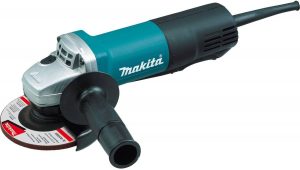Table of Contents
Introduction
An angle grinder or disc grinder or a side grinder is an efficient and versatile tool that is mainly used in workshops, construction sites, and auto repair. They come in a variety of sizes and motor power. The story about who invented the angle grinder is conflicting. Some say that it was invented by a man named Thomas Joseph in 1973 while others say it was invented in 1954 by a German company named Ackermann + Schmitt.
Uses Of An Angle Grinder
Angle grinders have different uses; they can be used to sand, buff, clean, sharpen and remove a variety of materials such as metal, ceramic, concrete, slate, masonry, rebar, bolt, wood and PVC pipes. It has different attachments that let you achieve all that function; the cutting discs and wheels are made for different tasks and vary according to the material it is being used on. They are used for both grinding and cutting through material and even to smooth out rough edges.
Also check: (What Are Angle Grinders Used For)
Cordless or Corded
Angle grinders come in two models, the corded and cordless. A battery powers the cordless grinders, and this provides the user with comfort and ease. You can easily transport them to remote areas and new worksites where there are no power outlets yet and as long as your battery is fully charged, you will be able to do your job for as long as you need to.
The corded model needs a power outlet to work, but they are known to be more powerful and provide you with more torque than the cordless model. Because they do not have a battery attached to them, they are lightweight, which reduced the fatigue felt by the user.
There are other factors that should be considered when choosing an angle grinder for a project. These factors include motor, disc size, rpm, arbor size and a pneumatic or electric power source.
Angle Grinder Attachments
The most commonly used disc sizes are 4 to 4.5 inches, and they are sufficient for general jobs. There are a variety of attachments that are compatible with an angle grinder; they are the:
Discs
Discs are round and thin angle grinder attachments that can be used for either cutting or grinding till they are worn to a small unusable disc. Their width ranges from 1/32-inch to ½ inch thick; they are referred to as wheels when they are thicker. It is advised not to use the thin disc for grinding as they will shatter. There are different kinds of discs that include the cutoff disc, the grinding disc and the sanding disc.
Although, the diamond-tipped discs are used for masonry and remain the same, they eventually become blunt because the diamonds are moved out of place by the cutting operation.
Pads
Pads are mostly used for grinding and finishing jobs. They are usually attached to a single backing plate that fits the spindle. They are not very durable, but they do a fantastic job when it comes to smoothing out metal surfaces without causing damage.
Wheels
Wheels are the thickest of all the attachments, and they are directly attached to the spindle. They are mostly soft wheels for smoothing and polishing but can also be solid abrasive wheels. The flapper wheels have plenty thin emery tap pads that are attached at the centre of the wheel and spread out for a soft polishing touch that smooths surfaces without so much pressure. Flapper wheels take a longer time to complete projects than finishing pads, but they cover a large area and leave you with a uniform finish. Polishing wheels are just like flapper wheels except that they have either cotton, tape, scotch, felt or nylon as the polishing substance.
Cutters
These are solid attachments that are longer in diameter than they are in width. They are used in cutting out holes and are fondly known as a core drill. They are either hollow or have sharp flutes or notches for cutting.
Safety Precautions
It is important to stay safe while operating an angle grinder. There are a few risks that need to be taken seriously, especially for beginners. Always remember to protect your eyes, wear a face shield and gloves and remember to turn off and unplug the grinder when changing wheels.
Ensure the workpiece is secured in place and keep a firm grip when operating the grinder. Position the grinder and workpiece in a way that the debris flies downwards and the wheel spins away from the workpiece and not into sharp edges. If the grinder catches on a sharp edge, it could cause the object to jump or the grinder to kickback. Ensure you read the safety manual of your angle grinder before you start operating it.
Conclusion
An angle grinder is a common tool known to most professionals and hobbyists. It provides you with an easier way to efficiently complete a project. An angle grinder is a smart investment when operated safely.

